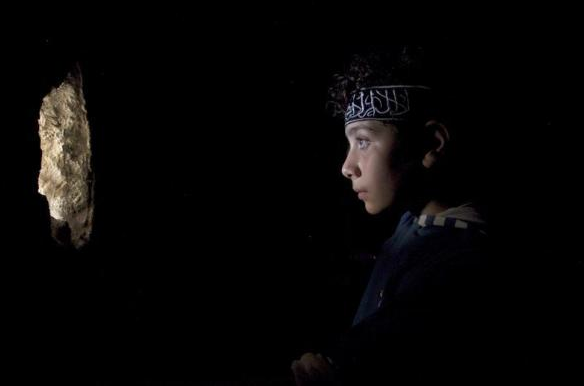Some photographs require that we ask the question we should ask of every photograph: What are we seeing?
A boy? A boy looking at something we can’t see? A boy posing for a photograph? A boy and some sort of mask? Perhaps a boy’s face shrouded in darkness and doubled by something inchoate; but what is that?
So we turn to the caption, as much for reassurance as for information. Reuters labeled the photo as “A Free Syrian Army fighter looks through a hole in a wall in Aleppo’s Saif al-Dawla district September 22, 2013.” OK, I guess that shape on the left is a hole, although it still looks like a brown papier mâché mask, something that is more akin to modern sculpture than conflict photography. It is a hole through which the light illuminates a rock wall, but the dimensions seem off or the perspective turned somehow. The odd shape, unfamiliar surface, and strict two-dimensionality of the image create a sense of optical distortion, almost like the anamorphic projection of a skull in Hans Holbein’s The Ambassadors. And so it could be a mask–or a death mask–after all.
Which is why I think the caption provides its own share of distortion. I’m sure it’s accurate enough, but really: did you see a “Free Syrian Army fighter.” Were the photo from Africa, wouldn’t he have been likely to be labeled a child soldier? And is he looking as much as he is being offered to our view? And does the place and date tell you anything about the substance of this photograph, that is, about this work of art? Captions are important, but they also can be instructions in how not to see what is being shown.
So it is that I grasp for analogies. Instead of a fierce freedom fighter, I see something closer to the funerary portraits of Roman Egypt. (The paintings were placed on the mummified remains, and masks were made as well.) Set amidst the dark background, the boy above seems almost to be a life-like image of himself (which, of course, he is to us). Lifelike yet motionless, showing both the mummified head and the painted face: it’s as if he were already dead.
And he may be. Aleppo is dying. Syria is dying. In the second decade of the 21st century, something of humanity itself seems to be dying. Because that has happened before, we know that the human spirit can be regenerative, but the photo may be capturing a glimpse, as if through that odd hole, of another turn in the story.
Perhaps the most disturbing aspect of this photo is how its slow, still artfulness may represent the way that Syria is dying. It’s as if the energy already has been directed to creating the semblance, crafting the memorial, and remembering the dead rather than saving lives.
Those on all sides seem content to let Syria die, while saving just enough to maintain appearances. If that’s so, all that’s left is portraiture.
Welcome to death’s studio. There’s a mirror if you would like to use it. We’ll be ready for you soon.
Photograph by Loubna Mrie/Reuters.

Discussion